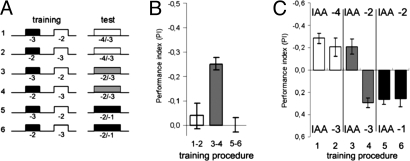Fig. 2.
Flies learn absolute odor intensity. (A) Experimental design. All six protocols show training with two dilutions of IAA (−3 and −2), with either −3 (protocols 1, 3, and 5) or −2 (groups 2, 4, and 6) dilution being paired with electric shock. Flies were tested at three different conditions regarding the two IAA concentrations (indicated by the white, gray, and black bars). In protocols 3 and 4 (gray bars) flies are tested at the training conditions (−3 vs. − 2). In protocols 1 and 2 flies were tested at dilution −3 vs. − 4 (white bars) and in protocols 5 and 6 they were tested at dilutions −1 vs. − 2 (black bars). (B) Learning scores. Protocols 3 and 4 give learning score for same concentrations during training and test (gray column). Flies that underwent shift-up (protocols 5 and 6) or shift-down (protocols 1 and 2) showed no learning, if learning scores were calculated according to the status of the relative concentrations as high and low in training and test. (C) PIs are half-scores. Protocols 1–6 in A correspond to columns 1–6 in C. Above and below the columns the dilutions are indicated that were used in the test. Columns 3 and 4 show the results of the standard experiment. In protocols 1 and 6 the concentrations avoided in the test matched the concentrations combined with electric shock during training but as relative concentrations have the opposite status with respect to that during training (switch from high to low and vice versa). In other words, if flies had relied on relative concentrations they should have avoided the other odor. In protocols 2 and 5 none of the test concentrations had been paired with electric shock during training. The concentrations avoided in the test are the ones closest to the shock-associated concentrations during training (generalization).

